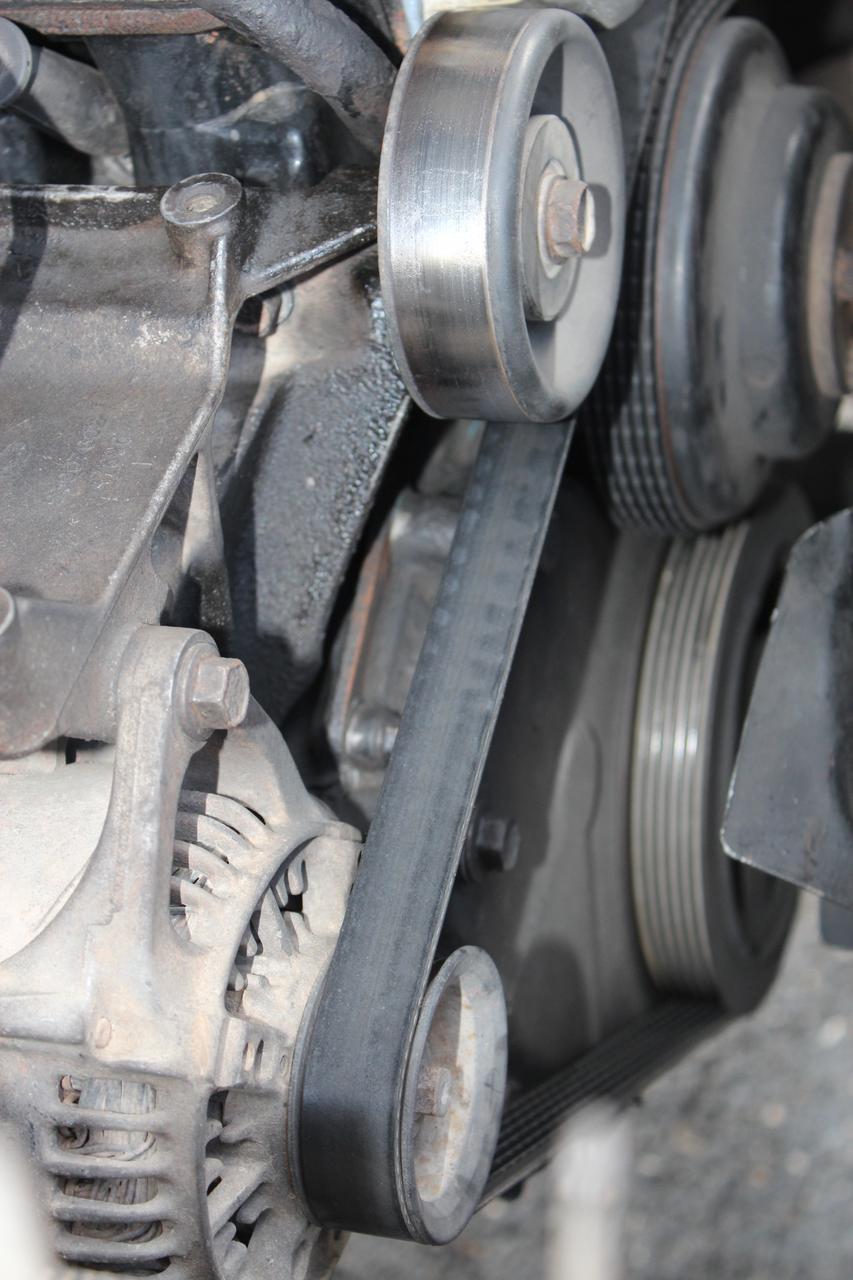A Home-made Bob Cat
My first introduction to a fan belt was in the early 1950s to see where the cat lost his tail. Daddy raised the hood on our green 1950 Ford pickup truck as I stood on the bumper to get a look. The severed half of a cat tail was lying near the carburetor, all white except for the red spot. Daddy pointed to the long black rubber belt and said, “Cat was lucky, could have been his head.” I remember that day and the awful deed it had done to the cat’s tail. We renamed him (Bob White). Daddy said, “Never put your fingers near a turning belt or fan, they will chop fingers.”
I was impressed to see so many things attached to that v-belt and as I recall, there were two water pumps, the fan, the generator, and the crank shaft at the bottom. A few years later I learned how to change worn out v-belts while working at our local Cities Service station as an attendant. I saw other cat, squirrel and small animal parts. Daddy was right, very dangerous! The big luxury cars were the most difficult because there were many belts, and they were well hidden. The bigger, newer cars had more accessories for the v-belt to turn that included smog pumps, alternators, water pumps, power steering pumps, air conditioner compressors, and a couple of things I never identified.
During the 1960s the lowly belt took a giant leap forward in design and function. It was given the chore of turning the engine camshaft. and the first one I ever saw was on a Pontiac Tempest with a six-cylinder engine. Followed by the Vega and the Pinto and many more…the old mechanics preferred chains and gears. The best they could say was, “Well, it is quiet”, and indeed all became quiet when they broke.
Belts improved in strength and durability. Today most vehicles have one belt that can turn every accessory under the hood. These new belts are called serpentine belts and they have a long life. They are very long and twist and turn like a snake. They cost more than the six belts they replaced, and every vehicle has a diagram under the hood for proper installation, very necessary for the average mechanic.
Belts have evolved from a flat piece of leather connecting two flat pulleys to today’s synthetic serpentine belt that will outlast most of the accessories they turn. The alternative to soft, flexible, quiet belts are the old tried and true gears and chains. Both require lubrication and adjustment.
Belt materials ranged from rubber to leather to ropes of cotton or hemp and even wire or cable. Belts were most often found in factories where sewing machines were powered by a long belt from a shaft in the ceiling. This enabled one electric motor to power 20 sewing machines. The other most popular place for the lowly belt was the American farm. The early tractors had a large flat pulley that would turn a long flat belt and operate water pumps, generators, milking machines, wood saws, combines or any number of implements that had to be turned. The belts for these applications have been replaced by the extendable drive shaft.
Spring is such a wonderful time when everything goes well, but this year is off to a bumpy start. We have a 14-year-old SCAG zero turn mower, and it is the answer to grass! We bought it in 2003 and used it to mow half of our Suffolk neighbors’ yards. After five years of mowing I replaced the blades just once because “no rocks.”
We moved to Monterey in 2006 and have now put five sets of blades (that is 15 blades) on the SCAG because there are “rocks”, many rocks, hard rocks. Back in 2010 the blade drive belt broke. In 2017 the blade drive belt broke again, that is 7 years per belt. Just last week I was enjoying my first Spring mowing event and poof, rumble, silence as the engine raced and a long thing (about 10 foot) was flung out in front of the mower! I recognized it immediately as about ninety $$$ bucks of misfortune! I ordered a new belt and finally got it on after donating blood, skin, and one fingernail to the effort! Took almost an hour, then I read the instructions.
I just love stories about old trucks/tractors, cats, and helicopters. The Army training helicopter was a Hughes 269 the Army designated as *TH-55; it was a tough, small, simple machine that would fly safely and forgive mistakes. It had a six-cylinder engine with fuel injection and would carry two soldiers, one learning to fly it. The only part I did not like was the tail rotor because if it breaks, the helicopter spins out of control! To make matters worse, it was driven by 8 V-belts! We were told not to worry, it would fly safely with only 4 belts. I never knew of an accident due to belt failure.
I have spent a lifetime depending on belts in a variety of machines. It now appears I have another 7 years of dependable grass cutting ahead, then at 79, me and the SCAG will both need new belts and a tune up of Geritol and Sea Foam.“
- Geritol- a people additive for tired people. Claims to maintain healthy energy levels.
- Sea Foam- an engine additive that dissolves carbon in the engine, the Geritol for tired engines.
- TH-55- Training Helicopter, built by Hughes Tool Company in Culver City, California. Army helicopters are named after American Indian tribes, and this one was named the OSAGE. Army pilots nicknamed it the “Mattel Messerschmitt.”
